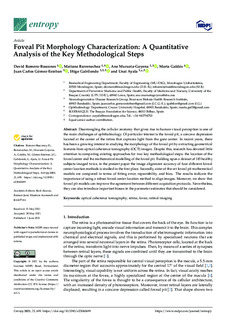
Izenburua
Foveal Pit Morphology Characterization: A Quantitative Analysis of the Key Methodological StepsEgilea (beste erakunde batekoa)
Argitalpen data
2021Beste erakundeak
Universidad del País Vasco/Euskal Herriko Unibertsitatea (UPV/EHU)BioCruces Health Research Institute
Hospital Universitario de Cruces
Ikerbasque
Bertsioa
Bertsio argitaratuaDokumentu-mota
ArtikuluaArtikuluaHizkuntza
IngelesaEskubideak
© 2021 by the authors. Licensee MDPISarbidea
Sarbide irekiaArgitaratzailearen bertsioa
https://doi.org/10.3390/e23060699Non argitaratua
Entropy Vol. 23. N. 6. N. artículo 699, 2021Argitaratzailea
MDPIGako-hitzak
optical coherence tomographyretina
fovea
retinal imaging
Laburpena
Disentangling the cellular anatomy that gives rise to human visual perception is one of the main challenges of ophthalmology. Of particular interest is the foveal pit, a concave depression located at ... [+]
Disentangling the cellular anatomy that gives rise to human visual perception is one of the main challenges of ophthalmology. Of particular interest is the foveal pit, a concave depression located at the center of the retina that captures light from the gaze center. In recent years, there has been a growing interest in studying the morphology of the foveal pit by extracting geometrical features from optical coherence tomography (OCT) images. Despite this, research has devoted little attention to comparing existing approaches for two key methodological steps: the location of the foveal center and the mathematical modelling of the foveal pit. Building upon a dataset of 185 healthy subjects imaged twice, in the present paper the image alignment accuracy of four different foveal center location methods is studied in the first place. Secondly, state-of-the-art foveal pit mathematical models are compared in terms of fitting error, repeatability, and bias. The results indicate the importance of using a robust foveal center location method to align images. Moreover, we show that foveal pit models can improve the agreement between different acquisition protocols. Nevertheless, they can also introduce important biases in the parameter estimates that should be considered. [-]
Sponsorship
Gobierno VascoProjectu ID
GV/Ayudas a proyectos de investigación y desarrollo en salud 2020/2020333033/CAPV/Aplicación clínica de la inteligencia artificial sobre imágenes de OCT de retina para la clasificación precoz y monitorización de pacientes con enfermedad de Parkinson/OCTBildumak
Item honek honako baimen-fitxategi hauek dauzka asoziatuta:





















